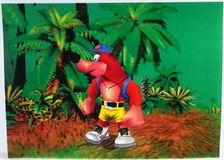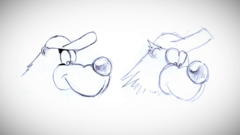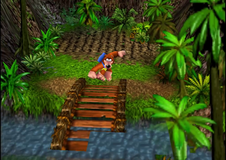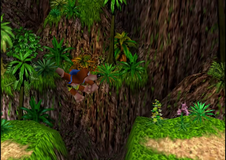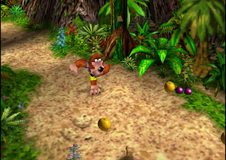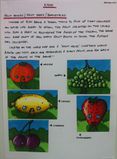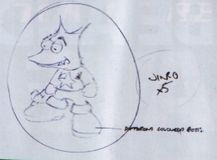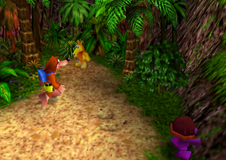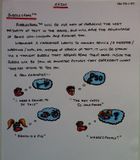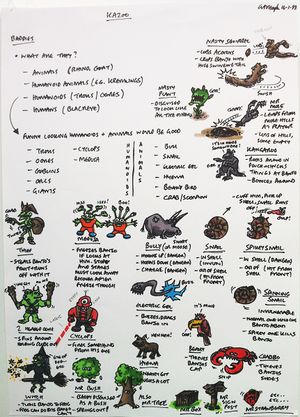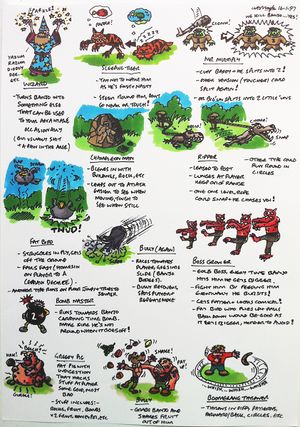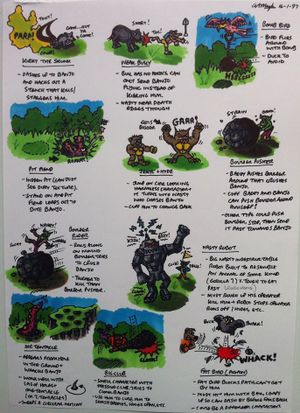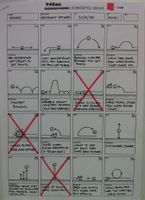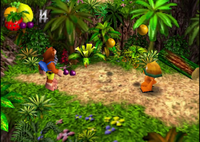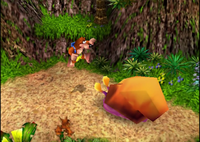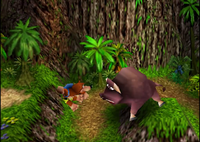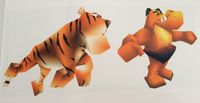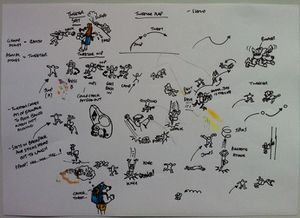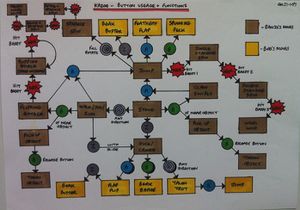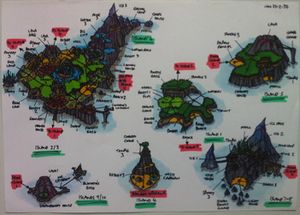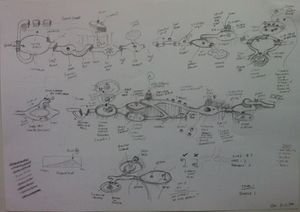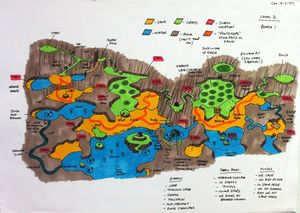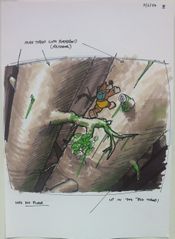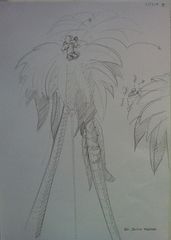Prerelease:Banjo-Kazooie/Kazoo
This is a sub-page of Prerelease:Banjo-Kazooie.
Contents
Introduction
It was now 1997. With Dream dead and buried, work began on a new game that, while mostly a clean break, would still retain some elements of it.[1] Since the bear character (henceforth referred to as Banjo) was so well-liked by the team, Stamper and Mayles elected to make the new title a platformer built from the ground up around him and his abilities.[2][3] This was a deliberate attempt to scale back development after Dream had gone astray; given Rare's prior experience with the genre, a platformer would be easier to put together in a shorter amount of time.[3][4]
Kazoo, as it would be named at this point (though Loveday once stated in 1998 that it had been known as Banjo)[5] was a 2.5D scroller that could be considered a direct spiritual successor to Donkey Kong Country, in that it adapted many of its design principles to fit a 3D environment; the team describes it as the nexus between their earlier DKC work and the final Banjo-Kazooie.[1] The Rare Revealed footage makes it bear (no pun) a passing resemblance to Crash Bandicoot, in that Banjo is seen navigating a jungle setting, picking up fruit, and killing enemies by jumping on them; he can move in any direction, but is restricted to a narrow path. Unlike Crash, though, Kazoo emphasized side-scrolling over forward-scrolling, with the latter only limited to the occasional branch away from the main path.[1][6] Concept art for the unseen second level (a beach) also indicates that other stages would have been more free-roaming than a typical Crash level, more similar to what Grunty's Revenge would be.
The game appears to still be running on Dream's mesh engine-- many of the tree graphics are the same as in Dream, and the path design looks quite similar. Lead programmer Chris Sutherland is quoted as saying that the team spent two months using Dream's "visual technology" to create Banjo before changing up their approach,[3] which would seem to coincide with the two months that made up Kazoo's development period. Regardless, much of Dream's support code carried over to the new iteration, which shortened its development time considerably.[3]
In retrospect, Kazoo somehow managed to be even more secret than Dream, as save for a blurry portrait in Banjo's house (long believed to have been depicting the lost Fungus Forest level from Banjo Kazoo), nothing whatsoever was known about a 2.5D version of the game until the Rare Revealed video... well, revealed it in 2015.
Basic Gameplay
Concept documents shared by Mayles on Twitter around the time of Rare Replay's release shed further light on Kazoo's design.
- One of the team's earliest ideas was to give Banjo a skateboarding bent, with a cap-and-shoes ensemble that lent itself to a skate-based moveset. The cap and shoes were also meant to tie into a clothing-based health system a la Ghosts'n Goblins: Banjo would lose the Cap after one hit, the Trainers after two, and his
shortslife after three.[7][footnote 1] To restore his health, he would need to find Cap and Trainers pickups within the level.[8] The idea was scrapped fairly quickly after the team realized it actually "wasn't that great"; Mayles mocked up the look by pasting a hand-drawn cap and shoes onto a printout of Banjo, only to find it so "awful" that he decided against having the artists model it.[1][9][6] While the skater angle is not present in the Rare Revealed footage, certain remnants of it can be seen (mainly Banjo's jump animation, which resembles a grab). - The fruits were equivalent to Donkey Kong Country's bananas, in that they were the most common collectible and would grant an extra life upon obtaining a certain amount (likely the standard 100). There were five different types to collect-- oranges, cherries, grapes, lemons, and strawberries. On top of extra lives, collecting fruit would award "Fruit Points", which can be glimpsed in the video-- oranges give Banjo 1 point, while cherries give him 10. Fruit Point totals would have been tracked by the game (individually?) and used to some end by visiting the five Fruit Houses—one for each variety—scattered about the world map.
- While almost certainly a coincidence, this is eerily similar to the fruit-collecting mechanic from earlier versions of Crash Bandicoot.
- This version, notably, marks the first appearance of the Jiggy. The concept of Jiggies stemmed from a wish by Stamper and Mayles to have the central collectible serve a purpose beyond taking up space on a status screen:
"Every self-respecting platform game hero has to have something to collect, but we wanted something that rather than being just a shiny object, was a shiny object that could actually be used for something [...] The desire to have a direct connection between this shiny object and opening up the worlds led to completing pictures of the worlds like a jigsaw, which in turn led to the missing pieces being the Jiggies."
- Gregg Mayles[3]
- Contrast the DK Coins of Donkey Kong Country 2—which only affected the player's percentage score—but compare Kremkoins from the same game, which could be spent to open up levels of the Lost World.
- Both level concept maps have 5 Jiggies each, suggesting that this was the standard number per level. (When you consider how many levels there were planned to be in total, that's a lot of Jiggies! No doubt either of these counts would have been trimmed down, had the game persisted further in development.)
- The Fruit Houses were also said to play a part in "recovering the pieces of the Jigsaw"; while it's never stated how, it's possible that Fruit Points could be redeemed for Jiggies (much like how in Donkey Kong 64, a number of Golden Bananas were obtained by trading in blueprints).
- An odd NPC named "Mr Fruito" is listed as one of the Jiggy objectives for Jungle 1, which may have been related to this.
- Jinjos also make their debut here. Like Jiggies, Jinjos originated as a spin on standard collectible design:
"Jinjos came from a years-old idea (dating back to Donkey Kong Country) of having a 'hard-to-collect collectable'-- one that would run away or camouflage itself instead of dumbly sitting around waiting to be collected. Funny how things turn out, as the Jinjos never ran away and even whistled to attract your attention! Actually, they were probably the dumbest collectable ever."
- Gregg Mayles[3]
- The name "Jinjo" was derived from "Ginge", which was Kirkhope's nickname for Ed Bryan, the "esteemed ginger artist" who designed the Jinjos.[10][11] While intended as a lighthearted tease, the name eventually stuck because the team felt it was "a really good fit" for the creatures, especially given that the first Jinjo created was orange in color.[10] (As a further nod to their origin, Bryan is credited as Ed "Jinjo" Bryan in Banjo-Kazooie, Banjo-Tooie, and Banjo-Kazooie: Nuts & Bolts.)
- Also like Jiggies, each level was said to contain 5 Jinjos, just like in the final game.
- "Honeypots" are also mentioned as an item in the January 16th enemy document. They likely had nothing to do with health, as the Cap and Trainers were still a part of the game as late as February. They possibly granted invincibility or activated the "bearhug" powerup (see below)-- a similar item in Tooie's multiplayer mode renders the player temporarily invisible.
- The game was going to have no (or almost no) written dialogue whatsoever. Instead, characters communicated via a system of pictures inside thought bubbles known as "Bubblespeak". Mayles believed this would transcend the language barrier (and presumably, any localization difficulties) inherent to written text and would make the game "funnier" to boot.
- On an unrelated note, gold pieces are mentioned as a currency in this document, though that may have just been given for the sake of example. The closest final equivalent would be Notes (which become the de facto currency later on in the series).
Enemies
A document dated January 16, 1997 shows the nature of Kazoo's antagonists had not been fully nailed down yet, though the general running theme seems to be a mix of funny animals and humanoid mythological creatures. A few designs can be spotted in the video, such as the snail and bull; many others would make it into the final game (or other games) in some shape or form:
- A "nasty plant" camouflaged among other harmless ones.
- A "nasty squirrel" named Nabnut, who would either lob acorns at Banjo from a distance or tail whack him up close. The name would later be used for a friendly NPC in the final game's Click Clock Wood.
- "Mr. Mole", who would ambush Banjo from within a set of mole holes (similar to Mario's Monty Moles).
- A kangaroo that would "bounce around" and throw things stored in its pouch at Banjo.
- A goblin thief that would steal fruit from Banjo.
- A Medusa/Gorgon that would temporarily freeze Banjo if he met its line of sight.
- The above-mentioned snail would make itself invincible by hiding in its shell. If Banjo struck it from the front, he would pick up the shell and the snail would dash out.
- A spiky-shelled variant would do contact damage.
- Variants of both would spin around instead of staying put; like Bully, the spiky one would instantly kill Banjo if touched, while the normal one could only push him around.
- A cyclops that would fire lasers from his eye.
- An electric eel that would either buzz at Banjo or "drag [him] in" (presumably to a hole or nest, like Unagi in Super Mario 64 or the sea snakes in Majora's Mask).
- Electric eels named Frazzles appear in Tooie, though they swim around freely.
- A hyena that would apparently do nothing except be a "sneaky git" and laugh at Banjo.
- "Beaky" the bird would steal Banjo's Cap if he was wearing one (any resemblance to Klepto from Super Mario 64 is purely coincidental).
- "Crabbo" the crab would do the same for his Trainers.
- A witch that would turn Banjo into a frog, which would give him new abilities (likely similar to those of Winky from the original DKC). Possibly the first seed of what would become Gruntilda.
- Various baddies that would disguise themselves as harmless objects: Mr. Bush, Mr. Tree, Mr. Box, Mr. Signpost, Mr. Strawberry, and so on.
- DK64's Fungi Forest had a similar concept for one of its enemies, which was a Kremling disguised as a mushroom.
- This may have been where the "inanimate objects with googly eyes" concept endemic to Banjo and Rare originated from.
- A goofy-looking wizard that would transform Banjo in a way that would (usually) impede his progress, but could sometimes be used to his advantage instead.
- This is very similar to Mumbo's gameplay function, only the good transformations are the exception rather than the norm.
- A sleeping tiger that Banjo had to tread carefully around, as it was "fast [and] nasty" when awake.
- An early model of a tiger character was shared by Bryan on Twitter, but it's not certain if this was meant to be the same tiger.
- "Mr. Multiply", who would split himself into copies when attacked. Alternatively, a large version of him could split into two smaller ones.
- "Chameleon Man", who would camouflage himself in the scenery and attempt to ambush Banjo.
- A dog on a chain named "Ripper" (likely repurposed from Dream) that would lunge at Banjo if he got close (much like Chain Chomps in Super Mario 64). Alternatively, he would run around in circles instead. One possible level idea would have had him break the rope and chase after Banjo.
- A fat bird that would fly up into the air and attempt to squash Banjo on its way down. A variant would block his path until hit with something, which would make it fly upward just long enough for him to get past.
- A bully (who may have also been the one from Dream) that would shake down Banjo for his fruit.
- Yellow and black Klobbers in DKC2 are similar; they do not harm the Kongs directly, but can take away bananas and Extra Life Balloons respectively.
- Another type of Bully was a literal bull that would repeatedly charge at Banjo. This is likely the initial concept of what became the final game's Bigbutt.
- A weaker variant lacked horns and could only knock Banjo around rather than damage him (like regular green Klobbers in DKC2). However, it could still kill him indirectly if he was too close to a pit. Its model (see screenshot below) can still be seen in the final game's musical intro.
- One possible idea for a boss was one that would grow larger (and thus more dangerous) with each hit. Instead of beating him the usual way, the object was to feed him until he burst, making him look "fatter [and more] comical" in the process. The Fat Bird above was considered as a candidate for this.
- A kamikaze "Bomb Master" that would run towards Banjo carrying a ticking time bomb; it was in Banjo's best interest to avoid him before it went off.
- A "Greedy Pig" with indigestion would spew objects at Banjo-- usually refuse such as rocks and bombs (think Mini-Neckies or Kannons in the DKCs), but occasionally useful things such as fruit and honeypots.
- A "Boomerang Thrower" that would, predictably, throw a boomerang in various patterns.
- "Kirky the Skunk" (no guesses as to who that's referencing)[footnote 2], who would run up to Banjo and spray a foul gas that would either daze him or kill him outright.
- A Pit Fiend that would hide in a camouflaged hole and attack Banjo from below.
- A "Jekyl + Hyde"(sic) baddy that was harmless until attacked, upon which it would grow in size, turn aggressive, and start chasing Banjo.
- This is somewhat like Kruncha from DKC2, who would turn red and move faster when jumped on, and could not be defeated by the Kongs alone.
- The "Boulder Pusher" would roll around a heavy boulder Sisyphus-style trying to crush Banjo. Defeating him would leave behind the boulder, which Banjo could then roll himself. A variant would stop and send the boulder hurtling towards him.
- Another, tougher variant called the Boulder Rider would try to bowl over Banjo from on top of a fast-moving boulder.
- A giant, animalistic robot (tentatively named RoboKong) that was impervious to damage, but could be rendered inoperative by attacking its nearby controller instead.
- "Mr. Tentacle", who would pop out of a hole in the ground and sweep itself in a circular motion to attack Banjo.
- This is similar to the final game's Whiplashes and Whipcracks, though neither of them burrow.
- A small character wielding a massive club, that Banjo could lure along to smash other enemies and open secrets.
- Kosha from DK64 is essentially this combined with DKC2's Kutlass. However, while Kosha can be lured, he cannot interact with anything.
In addition, several other enemies are referenced by name in other, later documents, which would indicate they were designed later:
- "Mr. Helmet", a Jinjo-like creature wearing an oversized helmet (also seen in the Rare Revealed footage);
- A non-thieving crab enemy (possibly an early Snippet);
- A shark (possibly an early Snacker);
- A jellyfish;
- And "Dune Chomper", possibly an early draft of Chompa (or a variant).
Further driving home the DKC comparisons, the team also went as far as to pillage an old concept sheet from 1993 for movement patterns to base enemies off of. Unfortunately, the Kazoo date of the document isn't known.
Attacks and Abilities
Several concept documents detail Banjo's assortment of moves. Some can be seen in the Rare Revealed footage.
- His standing attack was the Claw Swipe, which made it into the final game but behaved differently. Instead of taking a step forward, Banjo simply stays put while swiping.
- His running attack was a handspring or "end-over flip", similar to Diddy Kong's cartwheel. Like the cartwheel, it could be chained into multiple enemies (with each spring gaining additional momentum), though it also came with a cooldown period in which he would be unable to attack again.
- Banjo could crawl in much the same way as Mario in Super Mario 64, something he can't do in the final game.
- His aerial attack was a midair somersault. While possibly unrelated, Chunky Kong would have a front flip as his aerial in DK64.
- Another scrapped move was an "Attack Double Jump". The DKCs allowed the player to jump in midair by rolling off a ledge beforehand; Banjo would be able to do the same with his handspring attack, which would allow him a second, farther jump accompanied by "lots of sparkles".
- Interestingly, the diagram shown makes the move look similar to Kiddy Kong's water skip in DKC3 (which is odd, given that nobody on the Banjo team worked on that game).
- Lastly, there was the "Bearhug"-- a form of invincibility where Banjo could instantly kill enemies by bearhugging them and earn progressively more valuable types of fruit (culminating in an extra life if enough were killed).
In addition to his melee moves, Banjo could make use of various sports balls to attack, in a direct parallel to DKC's barrels. These were:
- A water balloon that flew in a downwards arc before bursting;
- A baseball that would be thrown in a straight line, hitting only one enemy at a time;
- A football (soccer ball) that could be kicked along the ground (think the durians in Super Mario Sunshine);
- A bowling ball that would roll straight along the ground, killing enemies in one hit;
- An American-style football that would bounce along in a diagonal arc, potentially hitting multiple enemies;
- And a basketball, which was not used as a weapon, but rather with a hoop as part of an end-level "shoot for loot" minigame (akin to the end-of-level target in DKC2).
These balls (except for the basketball) each had accompanying power-ups that could enhance their function:
- The Balloon Inflator would give Banjo a steady supply of balloons for a short time,
- The Baseball Glove would allow Banjo to throw unlimited baseballs for a time (somewhat like the Golden Eggs in Tooie),
- The Football/Soccer Shoes would allow Banjo to dribble the ball and carry it past obstacles such as ledges,
- And the Football Helmet would cause Banjo to shoulder barge enemies until it wore off.
A shuttlecock and pool ball were also under consideration, as well as a cricket bat, hockey stick, and golf club.
Bear Meets Bird
| To do: Apparently Kazooie's personality is also based on some kind of British stereotype, is there a source for this? |
During the process of defining Banjo's moves, one of the team's ideas was to give him a double jump "based on Mario's but more flexible", such that the player "could double jump anywhere they liked".[2] However, they thought the sight of a bear doing a double jump unassisted looked odd, and needed some sort of justification. After much brainstorming, they came up with the "desperate" idea that a pair of wings would come out of the backpack to give Banjo a lift. Then, for a fast travel ability, a pair of legs would likewise sprout from the bottom and do the running for him. From there, the logical conclusion followed that these would belong to another character inside the backpack-- such as a bird. To stand out from Banjo, the bird was given various traits that offset his, such as a sharp-tongued personality, (and presumably also) red color and female gender.[2][3]
An undated concept document from around this time seems to be a further brainstorming of these abilities. Banjo's bird partner is given the name "Tweeter" here.
- "Tweeter Nip" (an early Rat-a-Tat Rap)
- Here Tweeter is shown poking her head away from Banjo, swinging him around 180°; in the final game, Kazooie faces the same direction as him.
- "Tweeter Flap" (an early Feathery Flap)
- "Tweeter Shit" (an early rear egg shoot... probably)
- "Tweeter comes out of backpack to peck Banjo when not moving" (an idle animation that made it to the final game)
- "Shits in backpack and sticks head out to laugh" (one that... didn't)
- Early diagrams of the Talon Trot, Beak Buster, and flying abilities, among others:
- Tweeter stands bolt upright during the Talon Trot, going in the direction Banjo faces.
- Two different versions of the Beak Buster are depicted: one where both Banjo and Tweeter are flipped upside down, and one closer to the final, in which they are rotated 90° (with Banjo facing upward and Tweeter facing downward).
- Additionally, Tweeter seems to think "Banjo = poop", which would be considered wildly out-of-character for the final Kazooie.
Another document dated January 27, 1997 details the game's control scheme. In this one, the bird has no name given and is simply "Bird".
- The Claw Swipe(s), Flap Flip, Feathery Flap, Beak Barge, and Beak Buster all have their final names and implementations.
- The aerial attack is referred to as the "Spinning Peck", which is either an early name for the Rat-a-Tat Rap or a different move entirely.
- The Talon Trot has its final name, but is controlled by holding Z and tilting the Control Stick in any direction. (Interestingly, this is also how it controlled in earlier versions of Grunty's Revenge.)
- Banjo could pick up objects by pressing B when close to one, and then throw them by pressing B again. Barrels would behave this way in DK64.
- He could also do various spin attacks:
- One behaved like DKC's trademark "hop-n-bop", in that it was triggered by jumping off enemies and could be chained up to three times.
- Another was performed by rotating the Control Stick while airborne, and could be chained in the same fashion.
The Rare Revealed build, having likely been the last one compiled before Kazoo was scrapped, features the bird, who (along with Banjo) uses an early model that still closely resembles the final one. These models would persist to Banjo Kazoo as well.
| Early | Final |
|---|---|
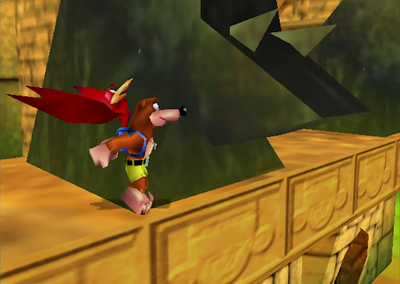 |
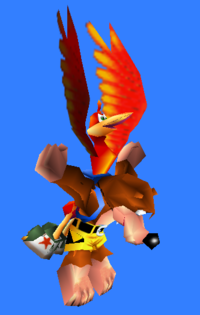 |
- Her wings lack the textured feathers.
- Her plumage is a cooler shade of red, with no yellow accents.
- Banjo's shorts are a cooler shade of yellow, and also lack texturing.
In addition, the Beak Barge and Feathery Flap can be seen in action:
| Early | Final |
|---|---|
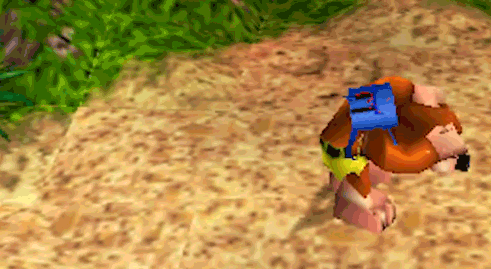 |
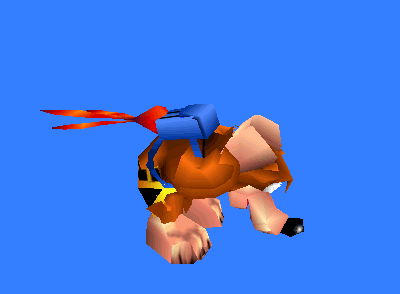 |
- Banjo gets into position almost instantly, but there is a longer delay before he lunges forward.
- The bird does not extend her neck during the lunge. (Ignore her tailfeathers sticking out of the backpack in the final image; that's just a quirk of the model viewer.)
- Interestingly, the shading on said tailfeathers is more consistent with the early model. They were likely not updated to match the rest of her.
| Early | Final |
|---|---|
 |
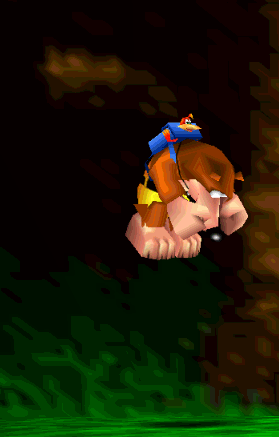 |
- The Feathery Flap has more bounce and a longer descent.
- The bird faces away from Banjo. Her wings also appear to be smaller, and she instantly disappears inside the backpack upon landing.
Musical Matters
Theming
One Dream element that carried over to Kazoo was its emphasis on theming. This eventually took the form of a musical naming scheme, which started when someone on the team pointed out the oddity of a bear named Banjo not actually playing the instrument that shares his name.[10][3] Soon other characters started being named after instruments, such as Banjo's little sister Piccolo[footnote 3] and his bird sidekick, who was given her (then-)final name of Kazoo to match her "annoying" personality (the fact that this was also the game's title was apparently a coincidence)[footnote 4]. A kazoo was also chosen for her so she could play a duet with Banjo, for "as yet unforeseen" reasons that would eventually evolve into the final game's "hoedown" intro sequence.[3]
Audio
Close to the end of Dream's development, DKC musician David Wise had been taken off the team to focus on RC Pro-Am 64, leaving Kirkhope in sole charge of the audio.[12][10] Kirkhope had written 107 tracks for Dream, but now found himself having to start over (mostly) from scratch, as the RPG-styled music clashed with the more lighthearted tone of the new game.[12] The first piece he wrote with the new direction in mind was (what would eventually become) the springtime version of Click Clock Wood.[12][13] Later, while looking for ways to add a more offbeat, quirky quality to the music, he would experiment further with the Beetlejuice-influenced style he had previously used for Dream's "Bully", and come up with a motif centered around alternating C/F♯ tritone chords to represent Banjo and Kazoo's contrasting personalities (F♯ being the furthest point from either C note in an octave).[13] This "oddball style" (as he put it) would become the basis for the rest of the game's (and in turn the series') soundtrack.[12][13]
Areas
Overworld
Long before Spiral Mountain or Grunty's Lair ever existed, Kazoo's world was made up of a chain of ten islands, with Banjo's house situated on the cliffside of the first (again, very Crash Bandicoot). One of the last known concept documents, dated February 23, 1997, was a layout of the game's map screen.
- There were at least 32 levels in the game, which were divided into twelve archetypes containing about three stages each: Jungle, Beach, Temple, Water, Forest, Mine, Fantasy, Swamp, Spooky, Lava, Ice, and Desert. A few of these archetypes also had their own separate race level, which were likely patterned after the races of the DKC trilogy (such as Screech's Sprint).
- On top of that, there are several other locations on the map that don't have numbers attached: Factory, Big City, Eskimo Camp, Bear Cave, Oasis Caravan, and so on. These were either their own archetype or special areas.
- There are also "Groves" of each type of fruit, presumably where the player would find a stockpile of them. An area full of oranges seen in Jungle 1 is marked "little grove" on the concept map, which would lend credence to this assertion.
- Captain Blackeye appears to still be the main villain, as a flying ship titled "Blackeye's Base" is situated at the end of Islands 9/10 (where one would expect a final boss to be).
- Captain Cockeye is also still in the game, as he has a lookout point on Island 2/3. It's not certain what kind of role he would have played, but if Dream was any indication, he likely would have at least been on the player's side.
- The map layout is far from linear, as larger islands have levels interconnected in a web.
- Several points are labeled something resembling "Mill", "Maill" or "Mhill". If the latter, then it could be short for "molehill", possibly indicating Bottles was in the game by this point. The multiple, evenly spaced occurrences of these areas on the map may point to molehills being used as a fast travel system around the archipelago (like Jamjars' silos in Tooie).
- Corroborating this somewhat are Tooie's level concept maps, which show that Bottles was originally going to return as the move tutor (instead of being killed off and replaced with Jamjars), with the warp pads (and presumably also the silos) instead being "transport molehills".[14]
Levels
Among the rest of the documents shared on Twitter were concept maps of the game's first two levels. Both were drafted in early February of 1997. It is not known if these were the only two created before the game was overhauled.
The first level, Jungle 1, is the one seen in the Rare Revealed footage. It was a mountain path that wound around a lopsided central peak; Banjo would venture from one side of the mountain to the other, encountering Snails, Mr. Helmets, and Bullies along the way. It ended on what would either be a gigantic column or the start of the next level (see below).
The second level, Beach 1, was a semi-open coastal cliff area strangely reminiscent of Breegull Beach from Grunty's Revenge.
- Footsteps in the sand indicated the intended pathway through the level.
- The shoreline would have alternated between high tide and low tide, adding or removing certain enemies from the area.
- 15 collectible shells were scattered throughout the level; one of the Jiggy objectives was to find at least 10 of them and take them to a hermit inside a cave. Breegull Beach would do the same thing, but with 5 shells (out of 5) and a seedy salesman instead of a hermit.
- There were numerous sand pits that had to be traversed for goodies, which were usually found closely packed together.
- One Jiggy was found inside an underwater cave. Breegull Beach would also hide a Jiggy under the sea, albeit in a section of deep water (though with the way diving is handled in Grunty's Revenge, it's basically the same as going inside a cave anyway).
- Interestingly, the basketball hoop is not present at the endpoint. It could have been scrapped, or it could have just been left out for detail's sake.
Two level ideas by Stamper both involved giant trees. One, titled "Up in the Big Trees", took place in a massive deciduous forest with no floor, where Banjo had to hop from branch to branch (similar to the redwood forest levels in DKC3). The other, titled "Big Jungle Treetops", was more tropical in nature, and focused on traversing treetops instead of branches.
Footnotes
- ↑ "Was really hoping 3=lose pants" "great idea, but we might have struggled to get an E rating."
- ↑ "Was Kirky the Skunk vetoed by @grantkirkhope ? :P" "well spotted! Mr. Kirky always had a certain aroma about him..." "The smell of success?"
- ↑ Note that, despite popular belief fueled by erroneous prerelease media, Piccolo was never Banjo's love interest.
- ↑ Loveday stated on the game's official web page that an early decision was to name the game after its characters, but Mayles claims Kazoo had its name before Kazoo(ie) was created (which lines up with the documentation).
References
- ↑ 1.0 1.1 1.2 1.3 Rare Revealed: A Rare Look at Dream - YouTube, Dec. 22nd, 2015
- ↑ 2.0 2.1 2.2 Dreaming of Banjo - Rare Replay, Aug. 4th, 2015
- ↑ 3.0 3.1 3.2 3.3 3.4 3.5 3.6 3.7 3.8 "The Making of... Banjo-Kazooie" (pgs. 19-25) - Retro Gamer #36, Mar. 2007
- ↑ Rare Vintage: Part One - Edge, Oct. 11th, 2010
- ↑ Rarewhere: Banjo-Kazooie - Rareware.com, May 14th, 1998
- ↑ 6.0 6.1 How ‘Banjo-Kazooie’ Became a Bridge Between Marios - The Ringer, Jun. 19th, 2018
- ↑ Gregg Mayles on Twitter: "Early Banjo wins! So here he is wearing shoes & cap, the 1st energy system idea. 1 hit=lose cap, 2=lose shoes, 3=die." - Twitter, Jul. 18th, 2015
- ↑ Gregg Mayles on Twitter: "#earlyBanjo wasn't fully 3D, more 'semi-3D' viewed from a fixed camera. Closer to DKC, actually. See early Beach too!" - Twitter, Jul. 22nd, 2015
- ↑ Gregg Mayles on Twitter: "@RiveraBK3 well spotted, [the shoes and cap] are hand drawn and glued on, I wanted to see what it would look like. Pretty awful was the answer!" - Twitter, Jul. 18th, 2015
- ↑ 10.0 10.1 10.2 10.3 Rare Revealed: Five Things You Didn't Know About Banjo-Kazooie - YouTube, Mar. 17th, 2016
- ↑ Scribes - Rareware.com, May 9th, 2008
- ↑ 12.0 12.1 12.2 12.3 Dream: The Game that Never Was - Grantkirkhope.com, c. 2010
- ↑ 13.0 13.1 13.2 Special Guest Grant Kirkhope - Guest Grumps - Game Grumps, Mar. 25th, 2013
- ↑ Tooie Concept maps for Glitter Gulch Mine, Witchyworld, and Terrydactyland.


